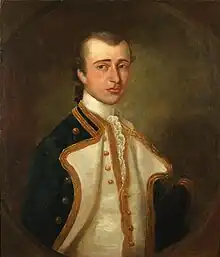Gamaliel Nightingale
Captain Sir Gamaliel Nightingale, 9th Baronet (15 February 1731 – January 1791) was an English landowner and Royal Navy officer.[2]
Sir Gamaliel Nightingale | |
|---|---|
 Portrait of Captain Nightingale[1] | |
| Birth name | Gamaliel Nightingale |
| Born | 15 February 1731 Kneesworth Hall, Cambridgeshire |
| Died | January 1791 Bassingbourn cum Kneesworth, Cambridgeshire |
| Allegiance | |
| Service/ | Royal Navy |
| Years of service | 1744–1779 |
| Rank | Captain |
| Commands held | HMS Badger (August 1757 – October 1758) HMS Vengeance (October 1758 – May 1761) |
| Battles/wars | Battle of Quiberon Bay |
| Relations | Nightingale family |
Early life and family
Sir Gamaliel was born at Kneesworth Hall, his family seat. He was the son of Sir Edward Nightingale, the 7th baronet, and Eleanora Ethelston. His older brother Edward succeeded to the Nightingale baronetcy on the death of their father in 1750. Sir Gamaliel succeeded his brother in 1782.[2]
Naval career
Nightingale's first command was HMS Badger in 1757.[3]
From 1758, he commanded HMS Vengeance.[3][4] In 1759, the Vengeance and its 200 men and 28 guns saw action off Quiberon Bay.[5] On 13 March 1761, while still commanding the Vengeance, he captured the 44-gun French privateer Entreprenant by Land's End.[6][2] He later took command of HMS Flora.[7]
He was a member of the Honourable East India Company.[3]
Nightingale Island
Sir Gamaliel is also known for exploring a small volcanic island near Tristan da Cunha, which in 1760 he named Nightingale Island.[8] Lying in the South Atlantic Ocean between Cape Horn and the Cape of Good Hope, it is part of one of the remotest archipelagos in the world.
The island is densely populated by wildlife, particularly birds, and is recognized by Birdlife International as an Important Bird Area. Two of the world's rarest birds are found only on the island: the Nightingale Bunting (4,000 pairs) and Wilkins's Bunting (approximately 85 pairs).[9]
References
- "Captain Gamaliel Nightingale". Bonham's. Retrieved 7 September 2023.
- Cokayne, George Edward, ed. (1900). The Complete Baronetage: Volume II. Exeter : W. Pollard & co., ltd. pp. 53–55.
- Winfield, Rif (2007). British Warships of the Age of Sail 1714–1792. Seaford. ISBN 978-1861762955.
- Rodger, N.A.M. (1986). The Wooden World: An Anatomy of the Georgian Navy. Naval Institute Press. p. 175-6. ISBN 0870219871.
- Troude, Onesime-Joachim (1867). Batailles Navales de la France, Volume 1 (in French). Paris: Libraire Commissionaire de la Marine. p. 385. OCLC 757299734.
- "No. 10090". The London Gazette. 24 March 1761. p. 2.
- "NMM, vessel ID 366908" (PDF). Warship Histories, vol vi. National Maritime Museum. Archived from the original (PDF) on 2 August 2011. Retrieved 1 December 2021.
- "Tristan da Cunha Nightingale Islands". Important Bird Areas factsheet. Tristan da Cunha Government & Tristan da Cunha Association. Retrieved 1 December 2021.
- "Nightingale Island group". Important Bird Areas factsheet. BirdLife International. 2012. Archived from the original on 10 July 2007. Retrieved 1 December 2021.